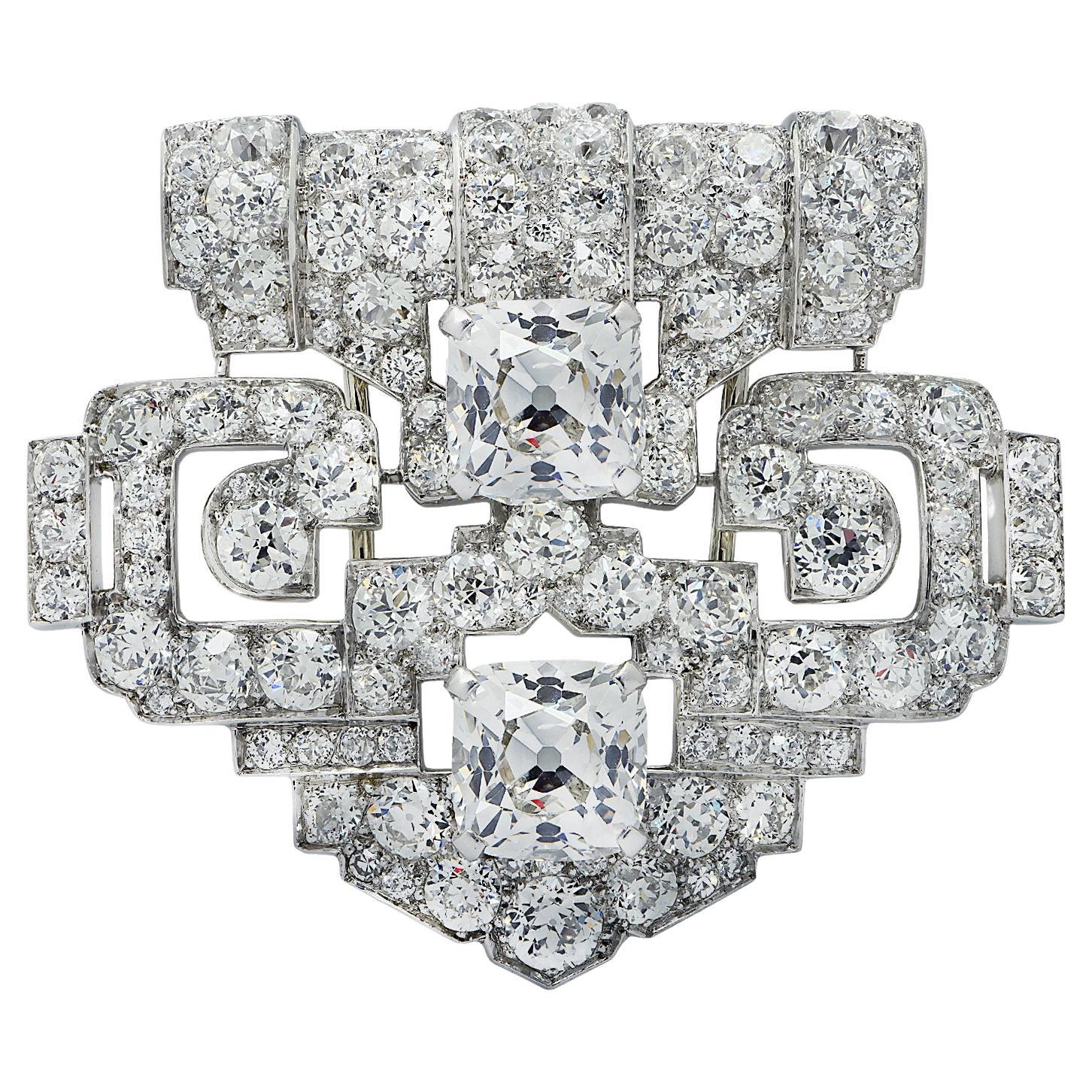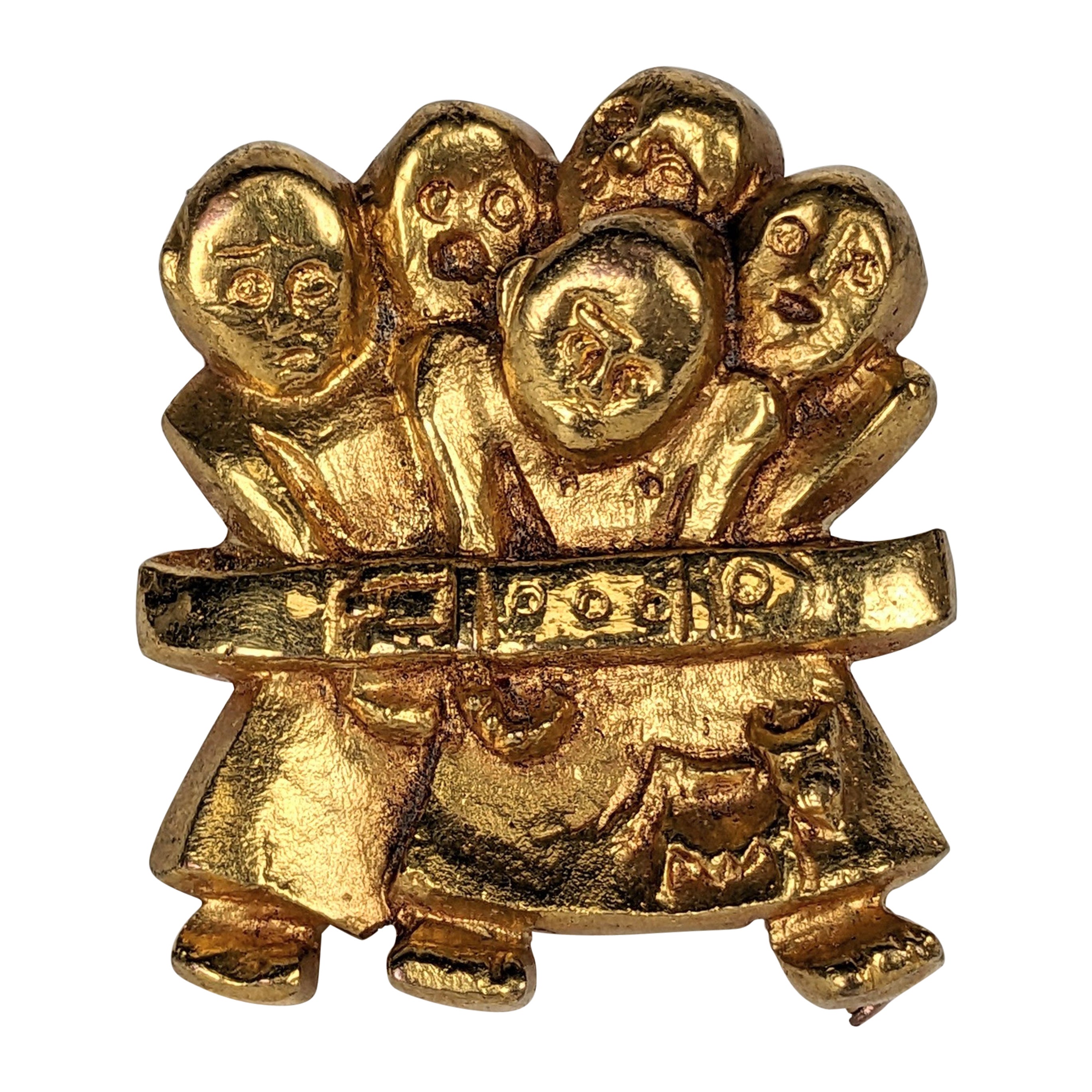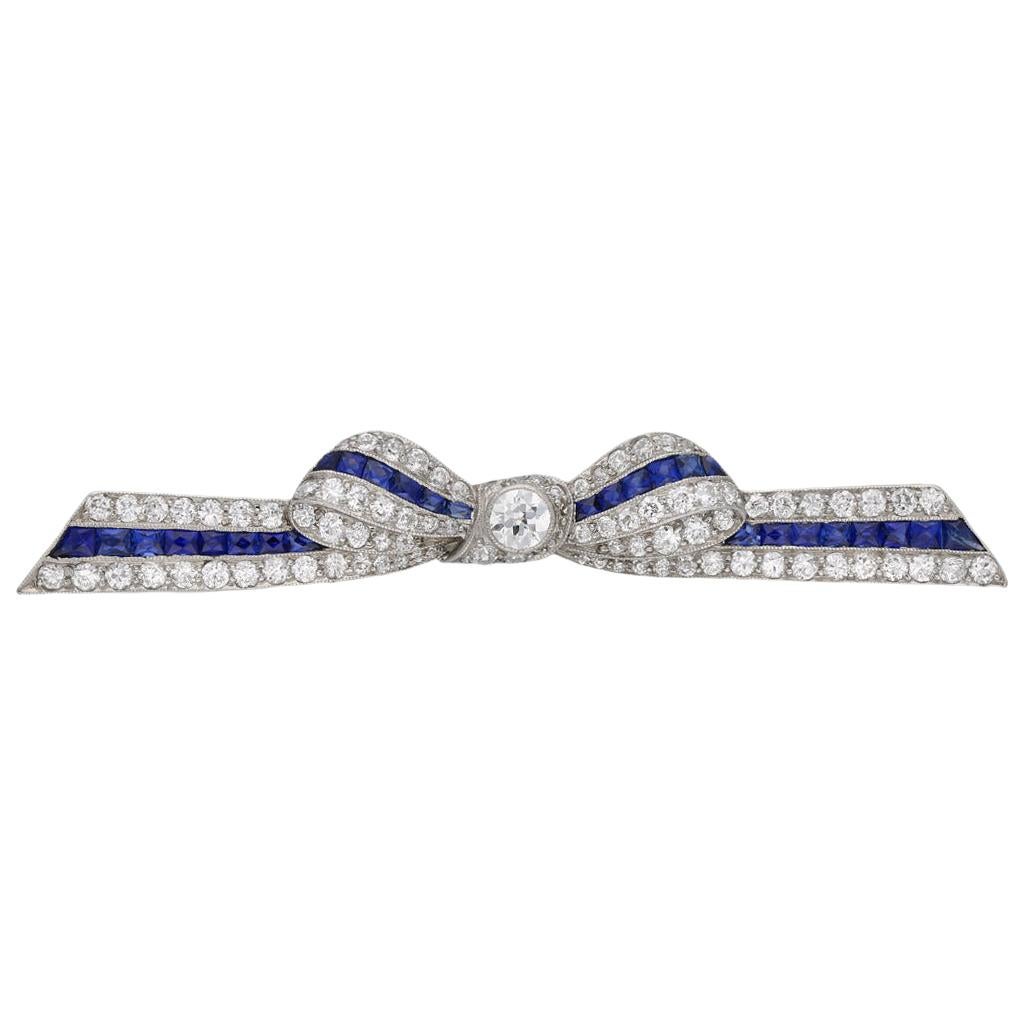Items Similar to ArtDeco c1925 Bakelite TriColor RedBlueGreen Carved Ribbon Bow BrassPinBrooch
Want more images or videos?
Request additional images or videos from the seller
1 of 6
ArtDeco c1925 Bakelite TriColor RedBlueGreen Carved Ribbon Bow BrassPinBrooch
About the Item
Antique ArtDeco-period Bakelite rare three-color ribbon bow hand-blended-and-carved brooch. Given the colors, narrow style, texture and affixed brass pin, this was among the earliest of the bow-themed costume jewelry that was sold in 1925 to Parisian tourists at the International Exposition of Modern Decorative and Industrial Arts. This world's fair with 15,000 exhibitors from 20 different countries gave the period its name.
The cute design seems inspired by acclaimed Parisian fine jewelry by Cartier which designed carved enameled bows in similar bright colors and size--but in precious metals and stones, some of which currently cost upwards of $35,000.
We suspect it was a fashion-show favor for guests, which would have especially amused couture buyers who may have also owned such a Cartier piece.
- Metal:Brass
- Weight:3 g
- Dimensions:Height: 1 in (25.4 mm)Width: 3 in (76.2 mm)Depth: 0.25 in (6.35 mm)
- Style:Art Deco
- Place of Origin:Unknown
- Period:1920-1929
- Date of Manufacture:1925
- Condition:Wear consistent with age and use.
- Seller Location:Chicago, IL
- Reference Number:1stDibs: LU3244220019332
About the Seller
5.0
Vetted Seller
These experienced sellers undergo a comprehensive evaluation by our team of in-house experts.
Established in 2012
1stDibs seller since 2022
11 sales on 1stDibs
Typical response time: <1 hour
- ShippingRetrieving quote...Ships From: North Adams, MA
- Return PolicyA return for this item may be initiated within 1 day of delivery.
More From This SellerView All
- Couture CocoChanel Byzantine ThePurpleHeart PearlAmethystQuartz GoldMedallionBy ChanelLocated in Chicago, ILDuring the ArtDeco period when Gabriel "Coco" Chanel was at her peak as a Parisian couture fashion-designer in the early 1930s, this antique one-of-a-kind handcrafted gem-fringed and gilt-chain medallion brooch with trombone clasp was commissioned to accessorize one of her clothing designs. Marked only "FRANCE" like some early 1930s Chanel couture jewelry (without a brand stamp until the 1950s), its artistic origin is most likely from ornate organic-form sketches by her favorite parurer Fulco di Verdura. The Sicilian duke began creating fabric patterns for Chanel in 1927, which shortly expanded to fine jewelry beginning with custom pieces for herself. These include the iconic Byzantine-influenced gem-adorned cuffs referencing the Maltese military-cross, which the French designer can often be seen wearing in circa-1930s photos. This bright yellow-gold brooch suits goldsmith Verdura's early anti-Art-Deco aesthetic that was considered a radical departure from 1920s silver-tone jewelry, which otherwise featured linear geometric designs or figurative representation. The softly-shaped deconstructed gem-bouquet mixes amethyst and rose-quartz beads with natural Keshi pearls and intricate tiny gilt leaves, which are wired to a Baroque-motif open-work frame that dangles another gem surrounded by a thick gilt-rope halo. Notably, Verdura is credited with re-introducing since Victorian times the rope motif to jewelry. Since 1930, Verdura's unique style was influenced by travels with Chanel to explore Byzantine art, Baroque architecture, and exotic flora-and-fauna among his native Italian aristocratic estate. The legendary fashion-editor Diane Vreeland and American entertainment-stars were among the first Chanel clients to acquire couture real-gem-adorned jewelry made by Verdura, while one of the two brooches treasured by Vreeland was titled "Theodora". See our photo of the Byzantine mosaic of Empress Theodora, whose image wearing many teardrop pearls above her chest and surrounded by a golden halo seems to be the inspiration for this brooch. As one of the most important modern-design collaborations, Chanel's close relationship with Verdura lasted largely-undocumented years in Paris, until he launched his first outside jewelry venture with a Hollywood designer-boutique after emigrating to the United States in 1934. By 1939 as a financially-backed in-demand goldsmith, he founded the namesake jewelry-company Verdura in NYC. After he retired in 1973, the brand continued to operate without him with different owners. Given the duo's designs that played with historic and military references, Chanel's couture commission for this purple medallion may have been sparked in the early 1930s when the internationally-new...Category
Vintage 1930s French Brooches
MaterialsAmethyst, Pearl, Quartz, Gold, Gilt Metal, Yellow Gold
- Artist BertoiaStyle Hammered SterlingSilver SquiggleSpiral UndulatingWire BroochLocated in Chicago, ILThis modern mid-century abstract three-dimensional unsigned brooch is a single hand-hammered sterling-silver wire that was shaped by an artist into an undulating squiggle that ends i...Category
Early 20th Century American Modern Brooches
MaterialsSterling Silver
- 1994 Smithsonian ModernArt LavaRock Sparkling SterlingSilver EyeShaped BroochBy ContemporaryLocated in Chicago, ILLike the pendant collected by the Smithsonian American Art Museum, this bezel-set lava rock was handcrafted as a modern sterling silver brooch by studio-artist Joan Parcher...Category
1990s American Artist Brooches
MaterialsOther, Sterling Silver
- MiriamHaskell 1930s FrankHess TripleSeashell RussianGilt Flora WoodLeaf BroochBy Frank Hess for Miriam HaskellLocated in Chicago, ILThis early Miriam Haskell lacquered-shell and brass-decorated clip brooch was created by Frank Hess, her first designer since 1926. The 1930s brooch features three seashells supporti...Category
Vintage 1930s American Baroque Revival Brooches
MaterialsGold, Base Metal, Brass, Gilt Metal
- Antique Art&Crafts FiligreeGoldFill ScrollingTwisted DanglingHearts Shell BroochLocated in Chicago, ILEpitomizing the organic subjects and hand-craftsmanship spanning the Arts-&-Crafts to Art-Nouveau movements that were led in The United States by Louis Comfort Tiffany, this gifted o...Category
Antique Late 19th Century American Arts and Crafts Brooches
MaterialsChalcedony, Coral, Turquoise, Gold-filled
- Black Tahitian Pearl Dutch DroogDesign 1998 Unique ThirdNipple GoldDisk BroochBy Artistian MadeLocated in Chicago, ILIn the 1990s when the Dutch collective Droog introduced international leaders of late 20th-Century functional art such as Ron Arad, Marcel Wanders, Jurgen Bey, Hella Jongerius, and Tejo Remy, the Netherlands-based brand was one of the most successful producers of conceptual design. The collaboration was co-founded in 1993 in Amsterdam by the jewelry and product designer Gijs Bakker (b. 1942), who commissioned his protege French artist Frederic Braham in 1998 to create this one-of-a-kind brooch for his young Droog-represented jewelry line "Chi ha paura...?". The Italian phrase means "who is afraid of?". This natural satin-lustre South Sea black-Tahitian 15 x 10 mm baroque thick-nacred pearl, which is bezel-set in oxidized sterling on a sharp silver stud for push-back fastening as a lapel or tie pin, is surrounded by a removable textured gold disk brooch with the Chiapaura maker's mark, artist's signature, abbreviated year and assay symbol. Notably, while farmed pearls from this French-Polynesian region are scarce, it is rarer to find one over 12mm. This dark gray one is also exceptional for its desirable secondary tone of peacock green with minimal surface imperfections. From normal use, the unseen back of the disk is missing chips of ecru enamel where it contacts the fastening knob. This reveals that the disk is solid gold. Like other functional conceptual design represented by Droog, the brooch is more than a beautiful piece of fine jewelry featuring multiple contrasting elements, as it could be a provocative "third nipple" if worn on a tie or scarf. Given the Dutch origin of the brand, we recall the famous 15th-Century oil-painting by Johannes Vermeer, known as "Girl with a Pearl Earring". Who is afraid of girl or boy with a third nipple? We acquired this brooch from a jewelry collector who had purchased it from the Italian gallery...Category
1990s Dutch Artist Brooches
MaterialsBlack Pearl, South Sea Pearl, Pearl, Gold, Silver, Mixed Metal, Sterling...
You May Also Like
- Cartier New York GIA Certified 11.24 Carat Old Mine Cushion Diamond BroochBy CartierLocated in Miami, FLMagnificent Cartier Art Deco Platinum and Diamond Brooch featuring a matching pair of important Old Mine Cut Diamonds weighing 5.60 carats and 5.64 carats. Both accompanied by a GIA report stating that they are H color VS1 and H color VS2 clarity. This brooch comes with an Expertise letter from IAJA (international Antique Jewelers...Category
Vintage 1930s American Art Deco Brooches
MaterialsDiamond, Platinum
- Carved Coral Buddha Pendant in 18k Gold Set with Diamonds, Emeralds and RubiesLocated in Honolulu, HIMAGNIFICENT large vintage Buddha pendant brooch in 18K yellow gold. This gorgeous pendant features a stunning Buddha carved in natural coral set...Category
Late 20th Century Unknown Pendant Necklaces
MaterialsCoral, Diamond, Emerald, Ruby, 18k Gold
- Line Vautrin "La Manif" Gilt Bronze BroochBy Line VautrinLocated in New York, NYGilt brooch by Line Vautrin (1913-1997), circa 1945-46. The design is known as ...Category
Vintage 1950s French Artisan Brooches
MaterialsBronze, Gilt Metal, Gold Plate, Brass
- Vintage Ruby Onyx and Diamond Classic Car BroochLocated in London, GBHere we have a superb vintage brooch. The piece has been crafted from 18ct yellow gold into the shape of a classic car from the 1930s. Automobiles of the 1930s exhibited many notable...Category
Vintage 1930s Brooches
MaterialsDiamond, Onyx, Ruby, Gold, Yellow Gold, Enamel
- Marcus & Co. Sapphire and Diamond Bow Brooch, American, circa 1935Located in London, GBSapphire and diamond bow brooch by Marcus & Co, American, circa 1935. A yellow gold and platinum bow form brooch set with one central row of twenty eig...Category
Vintage 1930s American Art Deco Brooches
MaterialsDiamond, Sapphire, Platinum
- John Brogden Shell Cameo Brooch and Earrings, English, circa 1870By John BrogdenLocated in London, GBAntique shell cameo brooch and earrings by John Brogden, English, circa 1870. A yellow gold suite of jewellery, the brooch composed of a horizontally situated oval Bull’s Mouth shell cameo of the Greek goddess Selene riding a serpentine dragon in a rubover collet setting, encircled by a conforming frame of gold beading and twisted gold wire punctuated with four gold palmette form plaques engraved and decorated with dark blue enamel and placed at the cardinal points, the reverse mounted with a hinged pin and scroll clasp, the earrings each composed of a vertical oval Bull’s Mouth shell cameo engraved with a bust length portrait of Selene with crescent-set headdress, encircled by a conforming frame matching that of the brooch with the addition of a pendant decoration composed of a horizontal bar of gold beading and twisted gold wires suspending gold link chains graduated from centre and ending in conical gold elements, the reverses mounted with French wire fittings, all in a fitted red leather case, the interior marked ‘FIRST CLASS PARIS MEDAL/ 1855.1867.1851/ PARIS FIRST CLASS & LONDON PRIZE MEDALS/ JOHN BROGDON/ Goldsmith/ MANUFACTORY/ 16, Henrietta St. Covent Garden/ London’. The cameo—defined as a gem, usually either a mineral or a shell, upon which a design has been carved in relief—is believed to have originated in Hellenistic Greece, during the third century BC. These miniature sculptures, at that time confined to the medium of hardstone, are thought to have been made with the primary purpose of personal adornment. The same practice of mounting cameos in jewellery was then continued by the Ancient Romans, and they are known to have been worn by many a Roman emperor. After the fall of Rome the fashion for cameos went into a decline, until it was again revived during the Renaissance period, brought about by a keen interest in the ancient world. At this time both antique and contemporary cameos were mounted in jewellery, as well as collected as objet d’art. The art of cameo cutting was revived in Italy, where it would remain a centre for the coming centuries. Again there was a lull in interest in carved gemstones, until the Neoclassical revival of the eighteenth century, largely stimulated by the discoveries of the ancient Roman cities of Pompeii and Herculaneum. As with the Renaissance, antique specimens were generally prized over modern cameos, and the worldliest men in Europe held them among their collections of art and antiques. That said, carving centres in Rome and Torre del Greco (near Naples) in Italy were established in response to the demand of the Grand Tourists, who travelled to Italy and Greece to become educated in the wonders of the ancient world. It was at this time that shell cameos, mostly made in Torre del Greco due to its proximity to the sea, became more popular, owing to the relative ease in carving shell over hardstone. In addition to Rome, hardstone cameos also became a specialty of Idar Oberstein, Germany, which had a long history with both the gem mining and cutting trade. In a shift away from the collector’s cases of the previous century, the nineteenth century saw a strengthening in the fashion for wearable cameos. After the Empress Josephine donned a cameo-set suite of jewellery at the coronation of Napoleon in 1804, cameo jewellery became all the rage. Napoleon played a further hand in promoting the art by establishing a gemstone carving school in Paris, inspired by his appreciation for the arts of the ancient world. By the mid-nineteenth century shell cameos, in part due to their lightness compared with hardstone cameos, were the height of fashion. Large shell cameos as well as hardstone cameos were set into contemporary mounts, often as suites of jewellery. Some of the best cameos of the nineteenth century—carved by a select group of recognized carvers—were set into revivalist mounts, corresponding to the subject matter. In Victorian England cameo jewellery was particularly prized, due in part to the fact that the Queen owned and wore a number of cameo jewels. One example which can often be seen in official portraits is the Badge of the Order of Victoria and Albert, carved by Tommaso Saulini of Rome, who also produced cameos for the maker of the present suite, John Brogden. To meet demand some carvers set themselves up in London, including William Schmidt, a German carver from Idar Oberstein, who produced cameos for top London jewellers, including Brogden, Carlo Giuliano and Child & Child. In fact, Schmidt purports to have been the first to carve cameos out of opal, which Brogden reportedly displayed in the Paris Exhibition of 1878. An extant example, now in the collection of the British Museum, was set by the Giuliano firm. Regarding subject matter, cameos throughout time have been largely figural, from bust length profile portraits to scenes with multiple full-length figures, and sometimes animals. Ancient Greek and Roman cameos often depicted mythological scenes as well as contemporary figures. During the Renaissance, mythological scenes were popular, often taken directly from ancient sculpture, as well as portraits of notable contemporary figures. During the eighteenth and nineteenth centuries, due to the revivalist styles, both Renaissance and Classical subjects were copied and set into matching (and sometimes unmatching) revivalist mounts. From the Renaissance through the Victorian era, being able to recognize the source of the carving in a cameo was a mark of erudition, revealing in the wearer knowledge of Classical art. As mentioned, the present cameo parure...Category
Antique 1870s English Victorian Brooches
MaterialsYellow Gold
Recently Viewed
View AllMore Ways To Browse
Jewelry By Cartier
Art Deco Costume Jewellery
Art Deco Costume Jewelry
Deco Costume Jewelry
Antique Inspired Jewellery
Costume Couture
Enamel Bow
Antique Costume Jewelry
Antique Jewellery Costume Jewellery
Cartier Inspired
Antique Bow Brooch
Carved Stone Brooch
Antique Couture
Modern Art Deco Brooch
Antique Brass Pin
Antique Brass Pins
Cartier Carved
Ribbon Couture





